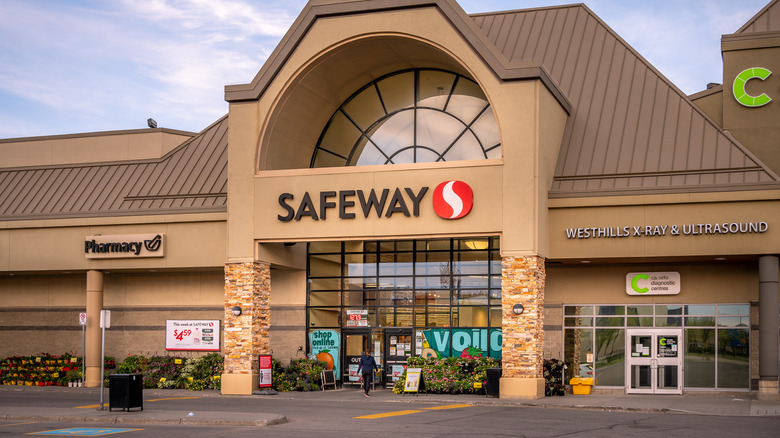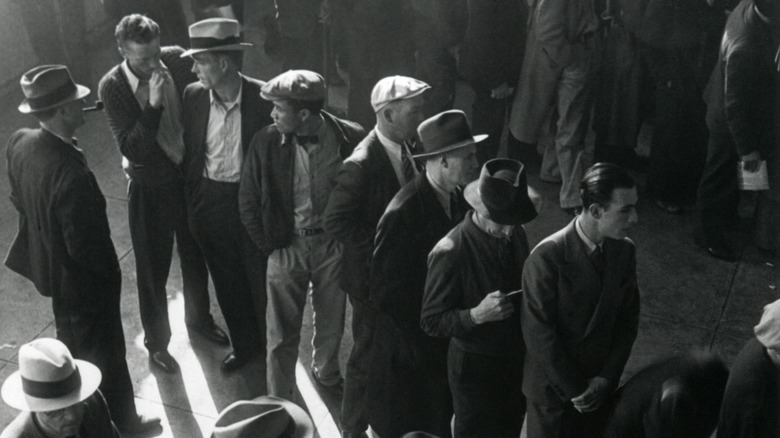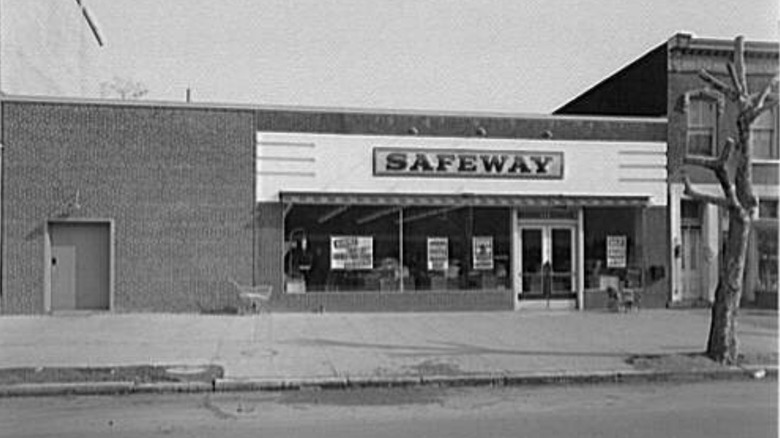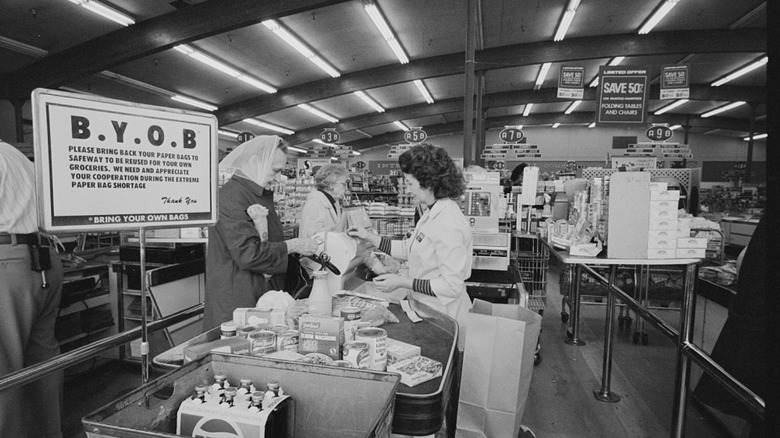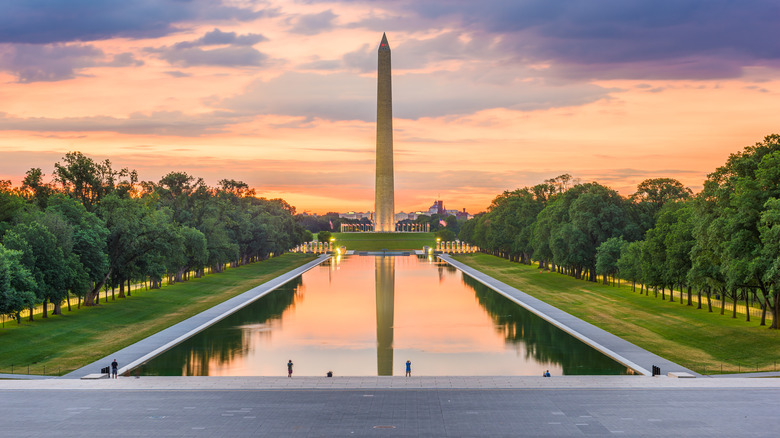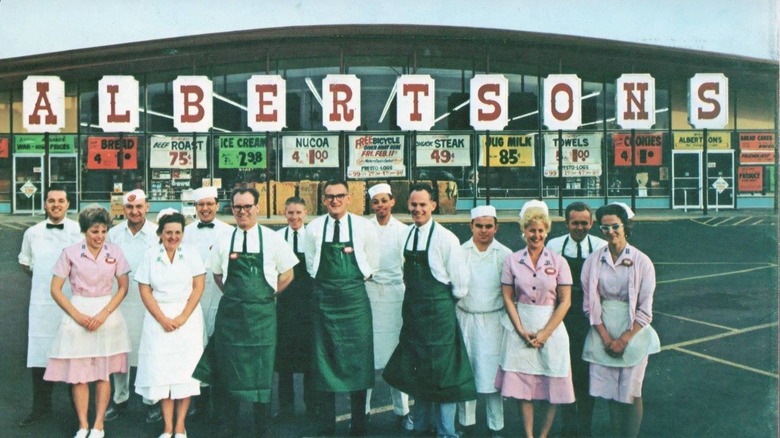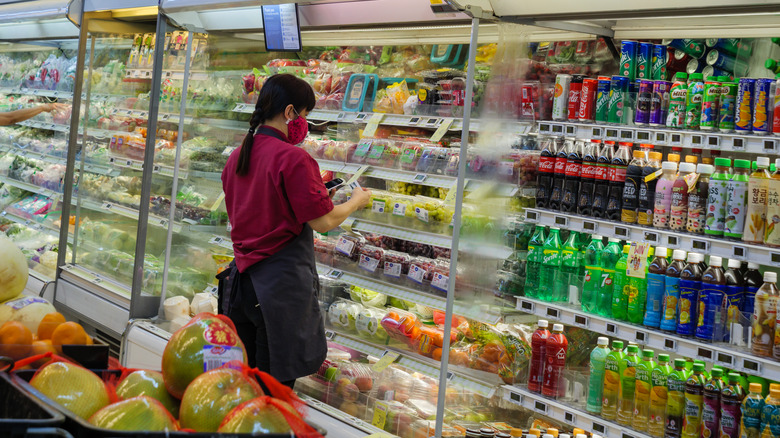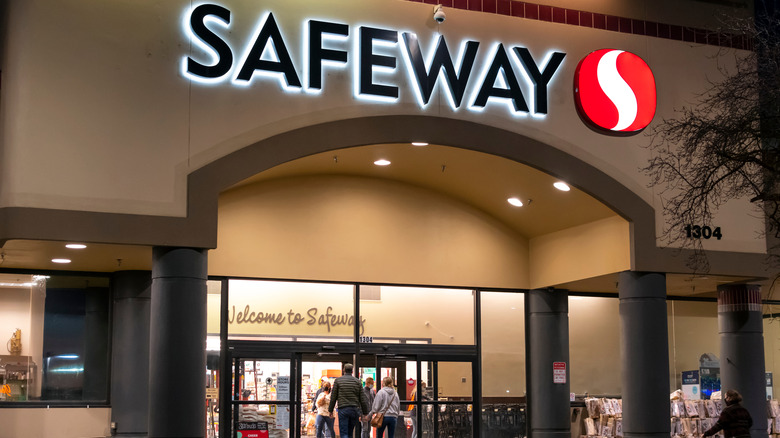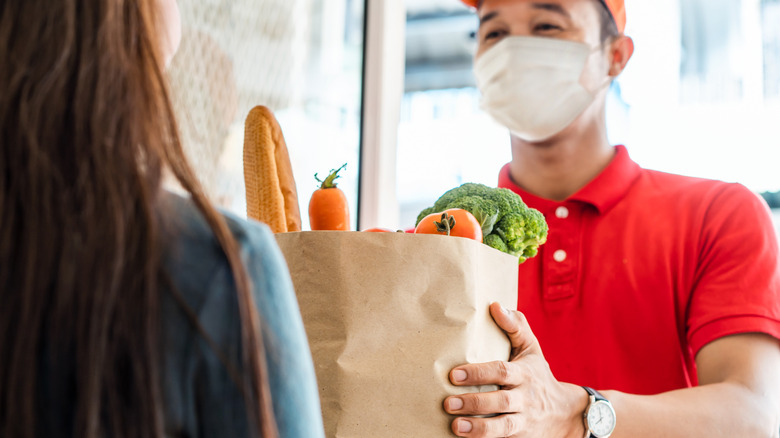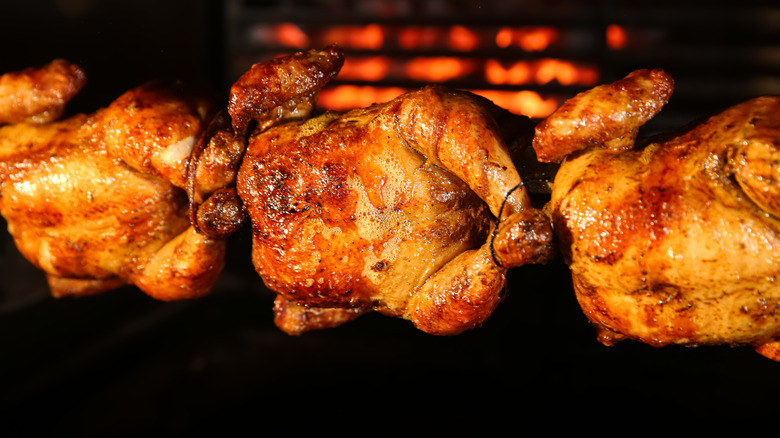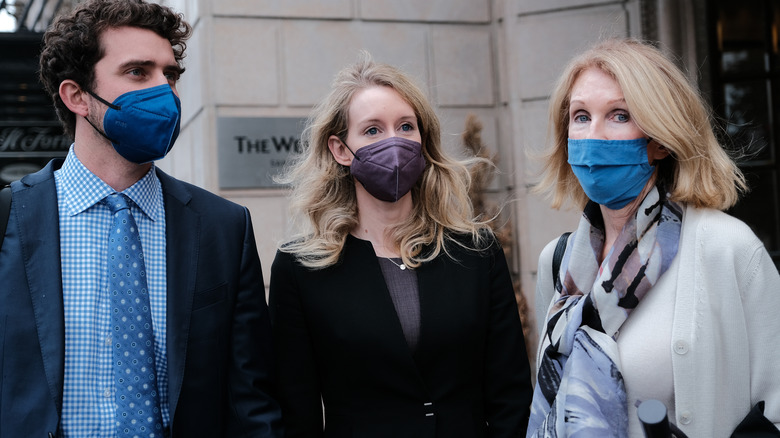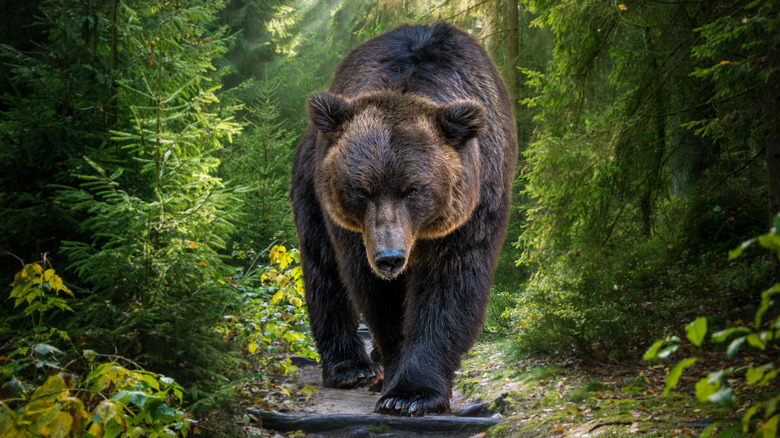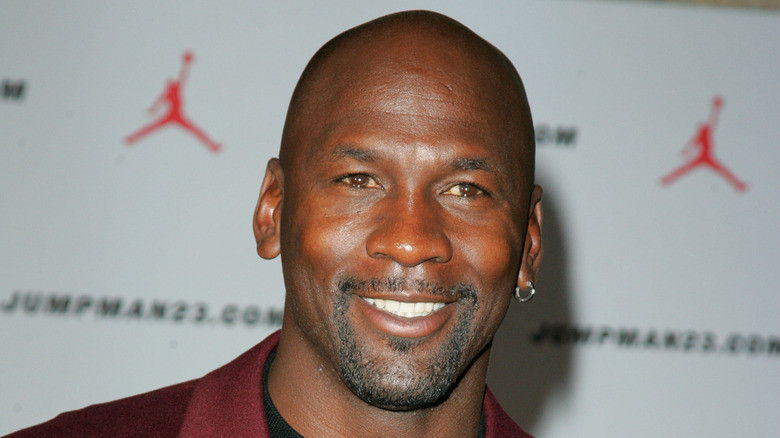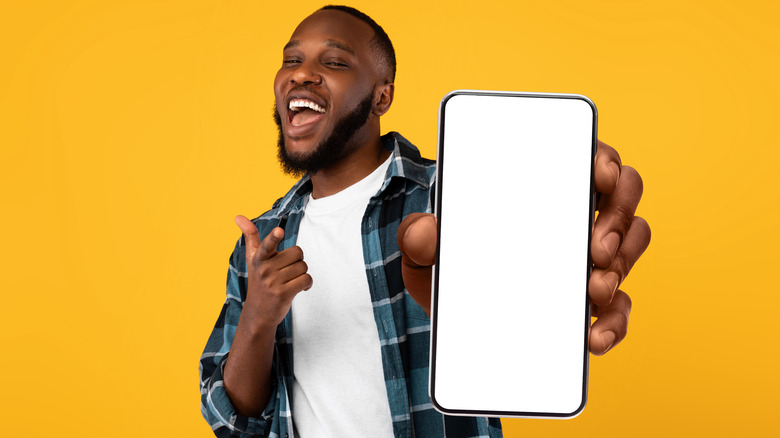The Untold Truth Of Safeway
You've undoubtedly heard of Safeway before, considering it's a major grocery store chain with more than 1,300 locations in 19 states and the District of Columbia. As a subsidiary of Albertsons, it ranks as the second-largest grocery store company in the country. Still, the retailer's history is richer than you might realize.
For instance, even though it's a major industry titan nowadays, its beginnings were much humbler. Safeway was the brainchild of M.B. Skaggs, an innovative young man who took over his father's small Idaho grocery store. He transformed the grocery store shopping experience with innovations that live on to this day. That doesn't mean the road has always been smooth. Today, the chain, as well as the rest of the retail industry, has struggled to stay open amid the ongoing pandemic. Safeway has even gotten mixed up in different scandals with more than one high-profile celebrity –- keep going to find out who.
If you want the nitty-gritty on one of the most prominent supermarket chains in the United States, then read on for the full untold truth of its 100-year history.
Safeway was designed to help families stay out debt
Have you ever wondered why the California-based grocery chain is called "Safeway?" In the 1920s, leading up to the Great Depression, consumer credit expanded exponentially in the United States as the Fed lessened credit requirements and decreased interest rates with the aim to increase lending, grow money circulation, and stimulate the post-war economy (via Investopedia). As a result, consumers started to buy more goods than they could afford.
S.M. Skaggs, a Baptist minister who owned a store in American Falls, Idaho, that would later spawn the Safeway empire, was skeptical of consumer credit. He believed it increased prices because grocers and storekeepers had to wait to get paid, and it made customers overly dependent on those grocers and storekeepers. He called selling items on credit "the growing evil of installment purchasing." Unlike other grocers at the time, Skaggs did not allow credit purchasing and ran his business on a "cash and carry" basis — that is, customers could only pay for goods in cash.
His philosophy apparently made an impression on his son, Marion Barton Skaggs, who later bought his father's store and turned it into the first Safeway. The name was a perfect fit: buying goods with cash instead of credit was the "safe way" to shop because shoppers only bought what they could pay for on hand, preventing them from going into debt as so many did in the Great Depression.
Safeway was originally a family business
Founded in 1915, Safeway was started by M.B. Skaggs, a 29-year-old well driller who bought a small grocery store from his father in American Falls, Idaho, according to The Spokesman-Review. Even though his father was in the ministry, he opened the grocery store to help feed their large family — Skaggs was one of 15 children. Back then, the store was named Skaggs Cash Store. Skaggs paid $1,088, which turned out to be a wise investment. By 1926, Skaggs "had opened 428 stores in 10 states," per the company's website.
In 1921, Skaggs relocated to Portland, Oregon, and teamed up with his five brothers to help manage the growing chain of stores. Their business strategy prioritized razor-thin profit margins coupled with low prices for customers, which proved to be successful. Skaggs practically doubled the size of his grocery chain when he merged with 322 Sam Seelig Company stores after winning a contest to rename the Seelig chain. "Safeway" won out.
This merger was orchestrated by Charles E. Merrill, the founder of brokerage firm Merrill Lynch, who financially backed Safeway. He played a crucial role in turning Safeway into the grocery store chain as it is today. He even left Merrill Lynch for a few years in the 1930s to run the newly incorporated Safeway, Inc., which had been listed on the New York Stock Exchange in 1928. Mr. Skaggs led the business for eight years before handing over operations to Lingan A. Warren in 1934 (via The New York Times).
Safeway was an early innovator in the supermarket industry
Like most supermarkets, Safeway had humble beginnings, but this doesn't mean the grocery chain's influence has been minor. Safeway is responsible for introducing numerous innovations in the grocery industry that many likely take for granted today. Safeway's founder, M.B. Skaggs, believed customers should help themselves as much as possible instead of relying too much on clerks. This is how Safeway became an early promoter of the self-service business model. Customers had easy access to items on shelves, which they put into baskets they picked up at the front of the store before checking out.
Safeway was one of the first adopters of "sell by" dates in the '30s, which helped customers know just how fresh their perishable goods were. The chain also began pricing its produce by the pound, which was another fresh concept at the time. And according to the company's website, Safeway deserves credit for another convenience: making some of the first parking lots. One of its later innovations came about in the '70s when it introduced unit pricing to help make it easier for customers to choose the "most economical" products, per The New York Times.
To this day, Safeway remains dedicated to pioneering industry solutions that put the customer first, such as its mobile app, which allows customers to shop remotely and then have their groceries delivered "in as little as two hours."
A Safeway subsidiary was once at the center of a landmark civil rights case
During the Great Depression, the Sanitary Grocery Store, a former Safeway subsidiary, played a pivotal role in civil rights history for Black Americans. It all started with the New Negro Alliance, a Washington, D.C., based organization that was established in 1933 by Black writers, activists, and lawyers with the aim to further Black employment via forms of action including boycotts and pickets. According to BlackPast, "it was the largest and most successful organization" of its kind at the time to promote civil rights through direct action measures.
The New Negro Alliance acted swiftly when Sanitary Grocery Store opened a new store in 1936 in a predominantly Black neighborhood, yet refused to hire Black employees. The very next day, the civil rights group organized a "Don't Buy Where You Can't Work" picketing campaign (via DC Historic Sites). While other businesses that were hit hard in the wake of the stock market crash recruited Black workers, Sanitary Grocery Store resisted and successfully sought an injunction against the New Negro Alliance. The grocery store argued that the civil rights group couldn't picket their business because none of the protestors were employees. Lawyers at the organization, including Thurgood Marshall, took the case "all the way to the Supreme Court." This resulted in the 1938 landmark decision of New Negro Alliance v. Sanitary Grocery Co., which ruled that the organization was legally within its right to picket a business even if the protestors weren't employed there.
Safeway led to the creation of Albertsons
Although Joe Albertson, the founder of — you guessed it — the grocery store conglomerate Albertsons, officially launched his business in 1939, his career in the supermarket industry started much earlier. In 1930, he was working at an Idaho Safeway as a clerk. Later, he became a Safeway district manager who supervised "more than a dozen stores," per the J.A. and Kathryn Albertson Family Foundation website.
It was at this point in his career that he decided to go into business for himself and create his own grocery store company. According to the Albertsons website, he saved $5,000 and borrowed another $7,500 from his wife's Aunt Bertie. He also teamed up with Safeway director L.S. Skaggs and Safeway accountant Tom Cuthbert. Albertsons opened its first store at 16th and State Streets in Boise, Idaho.
Apparently, Albertson learned a thing or two from his experience at Safeway since a local newspaper ad called the new business "Idaho's largest and finest food store." Albertsons expressed similar values as Safeway, such as fair prices, quality products, and good customer service. Albertsons grew to become a major competitor to Safeway, earning more than $1 million during its first two years of operation.
Safeway merged with rival Albertsons in a huge business deal
In early 2014, Albertsons and Safeway announced that the private equity firm backing Albertsons, Cerberus Capital Management, was planning to buy Safeway for $9.2 billion. This news represented a surprising twist of fate since Safeway was the very grocery store that Albertsons' founder started his career as a clerk at.
In a statement, Safeway president and CEO Robert Edwards, who became president and CEO of the newly merged company, said, "We plan to be the favorite local supermarket in every community we serve."
The merger wasn't clear cut, however. The Federal Trade Commission had to approve the merger to make sure the consolidation wouldn't eliminate competition and turn the merged company into a monopoly. Ultimately, the FTC approved the merger in early 2015 on the condition that the grocery store chain sell 168 stores to its competitors in the grocery sector.
The merger created a network of 2,200 grocery stores in 35 states and the District of Columbia, turning the company into one of the biggest grocery store chains.
Safeway has faced criticism during the COVID-19 pandemic
Grocery store workers have been one of the major groups hit hardest by the COVD-19 pandemic. Every day, they work in environments where social distancing is difficult, customers disobey mask rules, and workers come into contact with high numbers of potentially infected shoppers. While grocery stores have implemented health and safety measures, as well as hazard pay, for employees and customers, many Safeway workers have voiced concerns that the company's efforts have fallen short.
At the start of the pandemic, Safeway implemented an additional $2 per hour for its employees, an initiative the company called "Appreciation Pay." However, employees said this increase didn't adequately make up for the daily risks they faced as essential workers. What's more, the grocery store chain ended the bonus pay in June 2020 even though the pandemic continued to persist.
Employees have also blasted Safeway, arguing the chain took too long to implement basic safety protections. According to Bloomberg, Safeway failed to encourage employees to wear masks or gloves, resulting in a lawsuit after an employee died from COVID-19. An anonymous California distribution center employee told ABC10, "I might get in trouble for this... but [Safeway] hasn't really done anything." Shortly after, Safeway said it would give employees masks and gloves and take more temperatures.
Another employee at a Seattle store told Komo News, "The plexiglass was put in a month too late and in our store, it's literally three feet too short."
The future of Safeway looks uncertain
Like many businesses, the pandemic has hit supermarkets hard, and Safeway hasn't been immune to the economic recession. The New York Post reported in early 2020 that Albertsons, the parent company of Safeway, wouldn't be able to pay around $565 million in retirement accounts, impacting roughly 50,000 employees in the Washington, D.C., area. The company's underfunded pension woes came right as the grocery chain was trying to raise money via an initial public offering. Meanwhile, that same year, Forbes reported that Albertsons was the only grocer that had earned "a very high risk of default" rating from RapidRatings.
Individual Safeway stores have hit hard times as well. In San Francisco, a location at 2020 Market Street cut its hours of operation, citing claims of theft amid a generally struggling economy. And after a Tacoma location closed, the Tacoma Daily Index mused, "In the economy before 2020, there was a market demand for nine Safeways in Tacoma. By the end of 2020 there will be eight. Will there be even fewer a year from now?"
But as Safeway and other grocers navigate difficult financial waters, dollar store chains like Dollar General and Dollar Tree are reporting huge profit margins, according to The Washington Post. As prices rise at grocery stores because of inflation and the ongoing supply-chain crisis, Americans are shopping more at dollar stores than regular grocers, a trend that could hurt Safeway in the long term.
Safeway's grocery delivery services could use some improvement
Grocery stores everywhere have been ramping up their online shopping and retail offerings in recent years, and Safeway is no exception. With the rise of the pandemic, more and more shoppers are turning to grocery delivery services, but they're not all created equal, and Safeway's has a mixture of pros and cons. Most of its in-store products should be available for delivery, as well.
First, since Albertsons is the parent company of Safeway, they both share the same grocery delivery services. Your options are to shop for items on their website or use the app to add groceries to your cart and set up a delivery time. According to the company's website, the delivery window is limited to the hours of 8 a.m. to 10 p.m., but Safeway has same-day delivery, depending on availability. The first delivery is free, and as of this writing, Safeway also offers a $20 discount on first-time orders. Still, orders can err on the pricey side since Safeway charges a delivery fee of $9.95 and a service fee of up to $4.95, though fees are reduced for larger orders. That said, Safeway drivers don't take tips, so you can save some money there.
The biggest con against Safeway's delivery service is its app, which isn't user-friendly or easy to navigate. We recommend just ordering from their website instead.
Safeway's rotisserie chicken makes for a sweet yet savory meal
There's a lot to like about Safeway, but perhaps one of the chain's most underrated benefits is its rotisserie chicken. Although Safeway calls their signature spit-roasted bird a Traditional Whole Rotisserie Chicken, its untraditional flavor is likely to surprise you. The chicken is actually quite sweet-tasting, distinguished by a hint of orange flavor that is reminiscent of the orange chicken you might order at a Chinese restaurant. According to the nutritional labeling, the sweet flavoring likely comes from a combination of brown sugar, white sugar, corn syrup solids, and citric acid.
The unconventional flavor profile might not be to everyone's taste, but assuming you're looking for a chicken that goes against the grain, then Safeway's offering is probably your best bet. According to Consumer Reports, Safeway's chicken is healthier than some versions offered at other stores. Typically, rotisserie chickens are loaded with sodium, sugar, and processed ingredients, but Safeway has comparatively less sodium.
Bonus: you can rest assured there's nothing foul about Safeway's fowl since each bird is time-stamped. There's definitely no shame in eating one of their chickens the moment you return home, but you might as well take advantage of those time stamps and buy the freshest bird available.
How Safeway is embroiled in the criminal trial of Elizabeth Holmes
In 2010, Safeway partnered with now-defunct blood-testing startup Theranos on a $400 million deal that was supposed to help shoppers get faster and cheaper blood tests (via CNBC). The grocer built outpatient centers at more than 900 of its store locations, and Safeway even hired more than two dozen phlebotomists in anticipation of a deal that never got off the ground. After the Wall Street Journal published an expose in 2015 that revealed the shortcomings of the startup's technology, Safeway pulled out of the deal. Former Safeway CEO Steven Burd went on to testify against disgraced ex-Theranos CEO Elizabeth Holmes, who was charged with knowingly misleading investors, patients, and doctors about the capabilities of her company's technology to make a profit. At the time of this writing, the trial is ongoing. Holmes faces up to 20 years in prison, and she has pleaded not guilty.
"It was a fascinating concept," said Burd in his testimony about the blood-testing technology. Burd also characterized Holmes as a charismatic and convincing figure. According to CNBC, he swore Safeway conducted "at least 100" hours of due diligence before going into business with Theranos. Burd led Safeway from 1993 to 2013 and was one of the most high-profile names to testify in the trial.
Safeway wasn't the only retail chain to invest heavily in Theranos. Walgreens likewise partnered with Theranos until the pharmacy store chain dissolved its contract and sued the startup.
The so-called 'Safeway Bear' ransacked California stores
During the first summer of the pandemic, a black bear decided to go shopping at a Safeway in Lake Tahoe. A bold customer caught the bear on a cellphone video that shows the animal rummaging through the produce section before grabbing what might be a cup of yogurt in its massive jaws. Unsurprisingly, the video went viral, skyrocketing the bear to fame overnight. As a result, he was dubbed the "Safeway Bear."
The bear was also spotted munching on candy at a nearby convenience store and gas station. He even crashed a birthday party hosted at a picnic spot, where he sat down on the table and dug into the birthday cake. When the California Department of Fish and Wildlife officials captured the bear later that summer, they released him back into the wild.
Even though these incidents amused people under lockdown coast-to-coast, the story took a dark turn a year later. In August 2021, the roughly 15-year-old bear was shot at a campground near the Nevada border after he repeatedly approached a family with kids. The killing was considered "justified" because the family acted in self-defense. Fish and Wildlife officials noted, "The bear — once weighing more than 500 pounds — was a shell of its former self, completely emaciated, its teeth rotten."
Safeway once had to pay Michael Jordan millions in a settlement
In 2015, star athlete Michael Jordan took a supermarket to court — but not the basketball kind. The reason? One of Safeway's subsidiaries at the time, Chicago-based Dominick's, used Jordan's name to promote a product in a 2009 ad without permission. The ad attempted to capitalize on the basketball player's induction into the Naismith Memorial Basketball Hall of Fame to advertise the chain's steak in a special issue of Sports Illustrated. Even though only two people used the coupon, the court still ruled the supermarket chain had to pony up $8.9 million, per ESPN.
At first, Safeway argued that $126,900 was a sufficient payout, but Jordan and his legal team pushed back by getting an economist to testify that the fair market value of using his name and jersey number in the ad was actually $10 million. Despite the sky-high settlement, however, Jordan said he wasn't in it for the money. In fact, he planned to donate the millions to charity, though he didn't specify which one. He said he hoped "the size of the monetary reward will deter others from using someone else's identity and believe they will only pay a small penalty." Well, lesson learned.
Safeway is using TikTok-eque shoppable videos to drive online sales
In the era of short-form TikTok videos, it was only a matter of time before businesses jumped on the social media bandwagon to make more money, and Safeway is no exception.
According to Bloomberg, Albertsons, the parent company of Safeway, is stepping up its e-commerce game with short and snappy TikTok-style videos to lift the grocer's online sales and ad revenue. In late 2021, it partnered with Firework, a live-streaming startup that will bring videos to the retailer's website. According to Supermarket News, the second-largest grocery store chain is also the first to host videos on the Firework platform.
The "shoppable" videos turn social media users into customers, allowing them to interact directly with brands and their products. Shoppable video content enhances the typical online shopping experience by luring customers with ideas for recipes as they browse products. The partnership will also give Albertsons and Safeway the ability to track data about customers and gain insight into their shopping habits.
